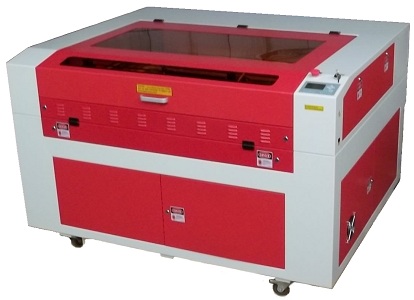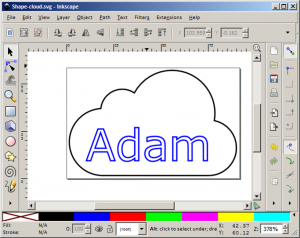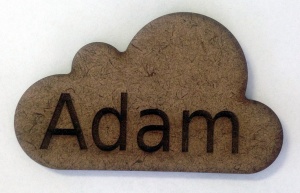Difference between revisions of "Laser Cutter"
| Line 204: | Line 204: | ||
=== Banned materials === | === Banned materials === | ||
| − | These materials should '''never''' be processed in the laser cutter. | + | These materials should '''never''' be processed in the laser cutter. This list is not exhaustive. |
{| class="wikitable sortable" | {| class="wikitable sortable" | ||
|- | |- | ||
Revision as of 17:54, 5 January 2018
| Rabbit QX-80-1290 Laser engraving/cutting machine | |
|---|---|
 Rabbit Laser Cutter | |
| Technical Specifications | |
| Bed Size | 1200 x 900 mm (47.2 x 35.4 inches) |
| LASER Power | 80W |
| LASER Type | Sealed CO2 laser tube |
| Max Bed Height | ~10 inches |
| Max Cut Speed | 36,000 mm/min |
| Max Engrave Speed | 60,000 mm/min |
| Max Engrave Resolution | 1000 DPI |
| Additional Information | |
| User Manual | RL-80-1290_User_Manual.pdf |
| Website | Rabbit QX-80-1290 Product Page |
The Laser cutter cuts or engraves digital designs on a variety of materials. Laser cutting is a great way to rapidly prototype projects.
An authorization workshop, hosted by an approved instructor, is required of all members before using the laser cutter. Workshops are posted on the calendar. Peer authorization is not an approved path for use of the laser cutter.
Interfacing with the laser cutter is performed with Laserweb.
The laser cutter does require regular cleaning and alignment. This is to be performed by trained volunteers only.
Contents
Usage
Safety
Fire Safety
Laser cutters pose a fire hazard. A high intensity beam of laser light can produce extremely high temperatures as it comes into contact with the materials it is engraving, marking, or cutting. When using the laser cutter, remember:
- You may only use the laser cutter if you have been officially authorized according to the machine access policy
- Never leave the laser cutter unattended while it was powered on (even if it is not firing)
- Never cut materials that you don't know are safe
- Never override laser cutter safeties and switches
- Know what to do if a fire happens
- Move the head out of the way, if it's small.
- Hint: Hit the big, red, emergency stop button. This will shutdown the laser and the air supply
- A Carbon Dioxide (CO2) fire extinguisher is located next to the laser cutter
- Verify it is out and then:
- Place a note that a fire occurred and the machine is out of service.
- Post on the forum about it, or send an email to fablab@makeict.org
- Someone from the laser group will check the machine, clean as necessary, and put it back into service.
Eye Safety
The laser is encased and will not fire unless the doors are shut. Do not bypass any safety lockouts or open panels without consulting the fablab lead first. Lasers can cause serious eye damage, even indirectly through scattered energy.
Air Safety
Many materials give off toxic fumes when cut. Do not cut unapproved, unknown or banned materials on the laser cutter. See the list of approved/banned materials on this wiki
Starting the laser cutter
- Check that the screen in the collection bin is clean and the bin is empty
- Start the laser cutter with the key switch
- Make sure the air compressor and the fan motor are on
- Home the head!
- If you do not do this, you may crash the head, which is not good
- Beware of flammable materials while using the machine
Workflow
A detailed step-by-step presentation of laserweb steps is here: Laserweb Screenshots
- On any computer - Create design
- Laser web accepts *.png, *.jpg, *.jpeg, *.bmp, *.gcode, *.g, *.svg, *.dxf, *.tap, *.gc, & *.nc.
- At the laser cutter computer
- Check the calendar http://makeict.org/lasercutter to make sure you're not running into a reservation
- Start laser web
- LaserWeb: Files tab
- Import your file into laserweb on the "files" tab.
- Create setup layers for each speed and power setting
- LaserWeb: Comms tab
- Turn on the laser cutter with the key switch
- Click "connect". If there is a circle slash over "connect", you are probably already connected
- LaserWeb: Controls tab
- Press Z up to increase distance between laser head and table
- Home laser head
- Load media into cutter
- Jog head to center of media
- Auto-focus
- Move laser to desired origin
- Set Zero
- Check Size
- Close lid then run job
- After cut is finished allow ~30 seconds before opening to vent smoke/fumes
When Finished
- Home the head
- Remove media and clear debris
- Power off
Common Issues
- Edges of cut pieces are slanted, rather than straight.
- The Laser is out of alignment and needs to be adjusted. Notify the Fab Lab Lead.
- The head crashes when approaching the left or bottom of the bed.
- The head must be homed before starting to cut. If it isn't homed there is a risk of crashing the head, which is a bad thing.
- Bed only travels downwards.
- The focus probe is stuck in the triggered position. Wiggle it loose and make sure nothing jammed.
- Focus probe is broken.
- There are spares in the kit in the cabinet on the left-hand side of the laser. When putting a thicker material in the cutter remember to lower the bed before moving the head.
- Fumes are not venting well.
- Ventilation fan needs to be cleaned. Notify the Fab Lab Lead
- Unexpectedly wide rotary attachment dimensions
- Machine Options > Worktable > RY axis pulse unit = .018238
- Head won't move, error shown in laser web software
- Home the head
Speed and Power Settings
Every material and sometimes even every day is different, but here are some starting points:
| Material | Power (%) | Cut Rate (mm/s) |
|---|---|---|
| Plywood - 6mm | 50% | 15 |
| Cardboard | 50% | 50 |
| Engraving | 2-15% | 300 |
Materials
Cutting a bad material in the laser cutter can be dangerous. Only approved materials should be cut, and banned materials should never be placed in or even around the laser cutter. Cutting an unknown material risks bodily harm and damage to equipment/facilities.
Resources
- Identifying Unknown Plastics by Make Magazine
- Beilstein test
- Polymer Identification (video) by Burnination
- Polymer Identification (PDF) by David A. Katz
- Density Column Using Recyclable Plastics
Approved materials
| Name | Notes | Warnings | |
|---|---|---|---|
Acrylic (aka Plexiglas, Lucite, PMMA) |
Cuts well, leaves a smooth polished edge. Higher powers can leave smoke/scorch marks along edges. Some people remove paper/plastic protection sheets before cutting. | ||
Cardboard |
Cuts well, can catch fire | FIRE hazard! | |
Ceramic |
Engraving only | Mirror surfaces can reflect the laser beam | |
Cloth (cotton, felt, hemp) |
Cuts easily | NO plastic coated or impregnated cloth! | |
Corian |
|||
Cork |
Cuts nicely, the quality of the cut depends on the thickness and quality of the cork. Engineered cork has a lot of glue in it, may not cut nicely. | ||
Coroplast (corrugated plastic) |
Difficult to cut through cleanly, due to the ribs. Multiple passes are usually needed. | ||
Delrin |
Comes in a number of shore strengths (hardness), the harder tends to work better. Great for gears! | ||
Glass |
Has a sandblasted look, #009900 glass works best | Mirror surfaces can reflect the laser beam | |
Leather, suede |
Leather is very hard to cut, can be if thinner than a belt thickness | ||
MDF, engineered woods |
May experience a higher amount of charring when cut | ||
Magnetic sheet |
Cuts easily | ||
Stone/Granite/Marble/etc. |
Engraving only | Mirror surfaces can reflect the laser beam | |
Matte Board |
|||
Melamine |
|||
Mylar |
Works well if it's thin. Thick mylar has a tendency to warp, bubble, and curl | Gold coated mylar will not work | |
Paper, card stock |
|||
Plywood, composite woods |
Contain glue, and may not cut as well as solid wood | ||
Pressboard |
|||
NON-CHLORINE Rubber |
DO NOT CUT unless the rubber compound has been tested | Beware chlorine-containing rubber! If you're not sure, assume you've got chlorinated rubber, and don't cut it. | |
Tile |
Engraving Only. | Mirror surfaces can reflect the laser beam | |
Wood |
Avoid oily/resinous woods | FIRE - Cutting oily woods, or very resinous woods can catch fire. | |
Wood Veneer |
Contain glue, and may not cut as well as solid wood | ||
Anodized Aluminum |
Engraving only. Vaporizes the anodized layer away | ||
Bare Metals |
Engraving only. | ||
Brass |
Engraving only. | ||
Coated Metals |
Engraving only. Vaporizes the coating away | ||
Painted Metals |
Engraving only. Vaporizes the paint away | ||
Stainless Steel |
Engraving only. | ||
Titanium |
Engraving only. | ||
PolyPropylene Sheet |
NOT FOAM | ||
PolyStyrene Sheet |
NOT FOAM | Tends to melt; avoid overheating. |
Banned materials
These materials should never be processed in the laser cutter. This list is not exhaustive.
| Name | DANGER | WARNING |
|---|---|---|
ABS (acrylonitrile butadiene styrene) |
Emits cyanide gas and tends to melt | ABS does not cut well in a laser cutter. It tends to melt rather than vaporize, and has a higher chance of catching on fire and leaving behind melted gooey deposits on the vector cutting grid. It also does not engrave well (again, tends to melt). |
Chlorinated plastics (PVC/Poly Vinyl Chloride, vinyl/pleather/artificial leather) |
Emits pure chlorine gas when cut! | Don't ever cut this material as it will ruin the optics, cause the metal of the machine to corrode, and ruin the motion control system. Bubbles yellow, smokes alot, STINKS!!!!! |
Coated Carbon Fiber |
Emits noxious fumes | A mix of two materials. Thin carbon fiber mat can be cut, with some fraying - but not when coated |
Fiberglass |
Emits fumes | It's a mix of two materials that cant' be cut. Glass (etch, no cut) and epoxy resin (fumes) |
Galvanized metal |
Emits dangerous fumes | Zinc fumes are poisonous. Galvanized metal should never be super heated (so don't weld on it either). |
Metal |
Power needed for LASER to cut metal | |
Milk bottles/HDPE |
Catches fire and melts | It melts, gets gooey. DON'T. Someone has to clean the hex worktable. |
Mirrored surfaces |
Will not cut, reflects laser beam | Mirror surfaces can reflect the laser beam, damaging the cutter's interior components. Some mirrored materials can be placed reflective-side down and cut. |
Polycarbonate/Lexan |
Cut very poorly, disbackground-color, catch fire | Polycarbonate is often found as flat, sheet material. The window of the laser cutter is made of Polycarbonate because polycarbonate strongly absorbs infrared radiation! This is the frequency of light the laser cutter uses to cut materials, so it is very ineffective at cutting polycarbonate. Polycarbonate is a poor choice for laser cutting. |
CDs, DVDs, Blu-rays, etc. |
Made of Polycarbonate. | |
PolyPropylene Foam |
Catches fire | Like PolyStyrene, it melts, catches fire, and the melted drops continue to burn and turn into rock-hard drips and pebbles. |
PolyStyrene Foam |
Catches fire | Like PolyPropylene. It catches fire, it melts, and only thin pieces cut. This is the #1 material that causes laser fires!!! |
Pressure treated wood |
Emits dangerous fumes | Should never be burned -- not in your fireplace, and definitely not in our LASER |
Printed circuit board (FR4 and other material types) |
||
Unidentified plastics/rubbers |
If you don't know what it is, don't put it in the LASER cutter | |
Plastics from The Yard Store |
They do not properly identify their plastics |

